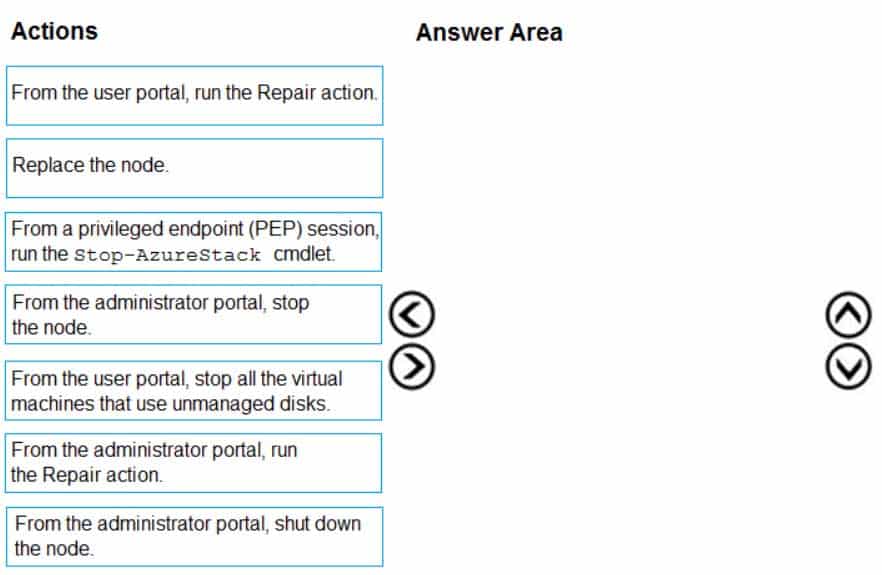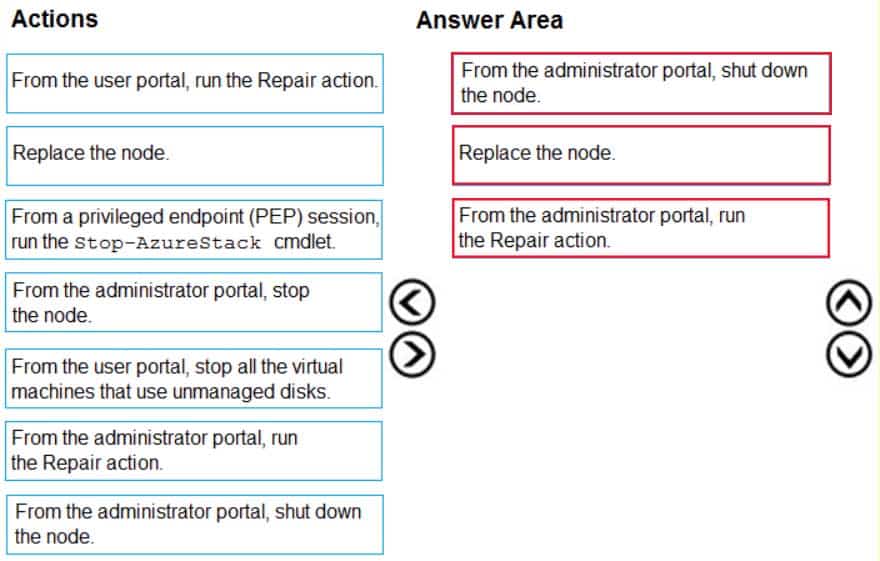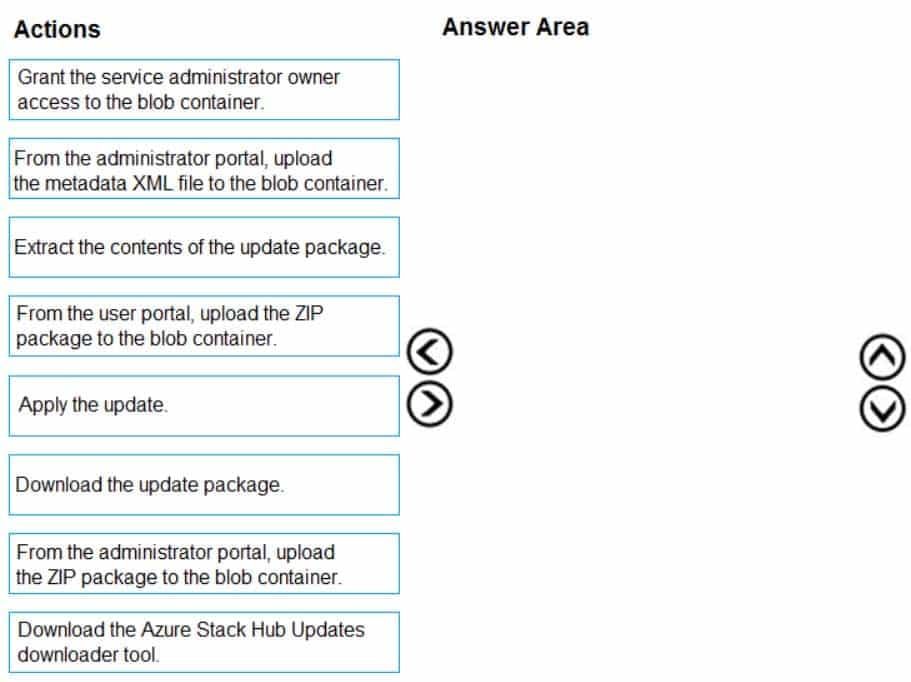AZ-600 : Configuring and Operating a Hybrid Cloud with Microsoft Azure Stack Hub : Part 04
AZ-600 : Configuring and Operating a Hybrid Cloud with Microsoft Azure Stack Hub : Part 04
-
You have an Azure Stack Hub integrated system.
The retention period for storage accounts is set to 10 days.
In a user subscription, a user deletes a virtual machine that has four 500-GB unmanaged disks attached.
How will the storage be reclaimed?
- The deleted storage can be reclaimed immediately by using the administrator portal.
- The deleted storage can be reclaimed immediately by using the user portal.
- The deleted storage can be reclaimed only after 10 days.
- The deleted storage will be reclaimed automatically in 10 hours.
-
DRAG DROP
You have an Azure Stack Hub integrated system that has 12 nodes. All the nodes run the latest firmware available from the OEM. The integrated system also has a hot spare node.
You receive an alert concerning the hardware on one of the nodes.
You need to replace the node as soon as possible. The solution must minimize disruptions to user workloads.
Which three actions should you perform in sequence? To answer, move the appropriate actions from the list of actions to the answer area and arrange them in the correct order.

AZ-600 Configuring and Operating a Hybrid Cloud with Microsoft Azure Stack Hub Part 04 Q02 040 Question 
AZ-600 Configuring and Operating a Hybrid Cloud with Microsoft Azure Stack Hub Part 04 Q02 040 Answer -
Eight hours ago, you received a critical alert for Azure Event Hubs.
A Microsoft Support Engineer requests that you send the Event Hubs logs only from the six hours following the alert.
Which command should you run from a privileged endpoint (PEP) session to collect only the required logs?
-
Get-AzureStacklog –FromDate (Get-Date).AddHours(–8) –Todate (Get-Date).AddHours(–2) –OutputSasUri "<SasUri>" –FilterByRole "EventHub"
-
Get-AzureStacklog –FromDate (Get-Date).AddHours(–8) –Todate (Get-Date).AddHours(–2) –OutputSasUri "<SasUri>" –FilterByResourceProvider "EventHub" -
Get-AzureStacklog –FromDate (Get-Date).AddHours(–8) –Todate (Get-Date).AddHours(–2) –OutputSasUri "<SasUri>"
-
Get-AzureStacklog –FromDate (Get-Date).AddHours(–8) –Todate (Get-Date).AddHours(–2) –OutputSasUri "<SasUri>" –FilterByNode "EventHub"
-
-
DRAG DROP
You have an Azure Stack Hub integrated system that is disconnected from the internet.
A new Microsoft update package is released.
You need to apply the update.
Which five actions should you perform in sequence? To answer, move the appropriate actions from the list of actions to the answer area and arrange them in the correct order.
NOTE: More than one order of answer choices is correct. You will receive credit for any of the correct orders you select.

AZ-600 Configuring and Operating a Hybrid Cloud with Microsoft Azure Stack Hub Part 04 Q04 041 Question 
AZ-600 Configuring and Operating a Hybrid Cloud with Microsoft Azure Stack Hub Part 04 Q04 041 Answer -
You are planning the deployment of two Azure Stack Hub integrated systems that will be located in Seattle and Redmond, respectively.
Workloads will run on infrastructure as a service (IaaS) virtual machines that have a static IIS web front-end and a Microsoft SQL Server 2019 cluster backend for database storage.
You plan to leverage Azure Traffic Manager to direct DNS requests to the integrated system in Seattle by default and use the Redmond integrated system in the event of a disaster.
What should you use to replicate application consistent database changes to the Redmond site?
- Hyper-V Replica
- Azure Blob storage replication
- SQL Server replication
- Azure SQL Database replication
-
DRAG DROP
You have an Azure Stack Hub integrated system that is registered to an Azure Active Directory (Azure AD) tenant named contoso.com. The integrated system region name is region1.
You need to retrieve only critical infrastructure alerts from the integrated system by using the REST API.
Which URI query should you use? To answer, drag the appropriate values to the correct locations. Each value may be used once, more than once, or not at all. You may need to drag the split bar between panes or scroll to view content.
NOTE: Each correct selection is worth one point.

AZ-600 Configuring and Operating a Hybrid Cloud with Microsoft Azure Stack Hub Part 04 Q06 042 Question 
AZ-600 Configuring and Operating a Hybrid Cloud with Microsoft Azure Stack Hub Part 04 Q06 042 Answer -
You have an Azure Stack Hub integrated system that is disconnected from the internet. The integrated system contains an Azure App Service deployment.
You anticipate a major increase in new App Service workloads. The integrated system has the required hardware to handle the increased demand.
You need to ensure that App Service can support the increased workloads.
Which three actions should you perform? Each correct answer presents part of the solution.
NOTE: Each correct selection is worth one point.
- Increase the user subscription quotas.
- Add an additional scale unit node.
- From the user portal, increase workers in App Service.
- Enable new identity and access management roles for the user subscription.
- From the administrator portal, increase workers in App Service.
-
Note: This question is part of a series of questions that present the same scenario. Each question in the series contains a unique solution that might meet the stated goals. Some question sets might have more than one correct solution, while others might not have a correct solution.
After you answer a question in this section, you will NOT be able to return to it. As a result, these questions will not appear in the review screen.
You plan to install an update to an Azure Stack Hub integrated system.
You need to verify whether the integrated system is healthy, and whether you can apply the update. You must achieve the goal as quickly as possible.
Solution: From a privileged endpoint (PEP) session, you run
Test-AzureStack –Group “Default”.Does this meet the goal?
- Yes
- No
-
Note: This question is part of a series of questions that present the same scenario. Each question in the series contains a unique solution that might meet the stated goals. Some question sets might have more than one correct solution, while others might not have a correct solution.
After you answer a question in this section, you will NOT be able to return to it. As a result, these questions will not appear in the review screen.
You plan to install an update to an Azure Stack Hub integrated system.
You need to verify whether the integrated system is healthy, and whether you can apply the update. You must achieve the goal as quickly as possible.
Solution: From the administrator management endpoint, you run
Test-AzureStack –Group “UpdateReadiness”.Does this meet the goal?
- Yes
- No
-
Note: This question is part of a series of questions that present the same scenario. Each question in the series contains a unique solution that might meet the stated goals. Some question sets might have more than one correct solution, while others might not have a correct solution.
After you answer a question in this section, you will NOT be able to return to it. As a result, these questions will not appear in the review screen.
You plan to install an update to an Azure Stack Hub integrated system.
You need to verify whether the integrated system is healthy, and whether you can apply the update. You must achieve the goal as quickly as possible.
Solution: From a privileged endpoint (PEP) session, you run
Test-AzureStack –Group “UpdateReadiness”.Does this meet the goal?
- Yes
- No
-
You have an Azure Stack Hub integrated system that is not yet in production and has no workloads running.
You configure the Infrastructure Backup Service, and you complete a backup.
You need to recommend a method to verify the restore process once the integrated system is in production.
What should you recommend?
- From the administrator portal, restore the domain controller backup to the default provider subscription and ensure that the domain controller starts successfully.
- Run Get-FileIntegrity against the infrastructure backup data files stored in the file share.
- Install the Azure Stack Development Kit (ASDK) and select the infrastructure backup data as the configuration during the installation.
- Instruct the IT team to redeploy the integrated system in restore mode by using the backup data.
-
Note: This question is part of a series of questions that present the same scenario. Each question in the series contains a unique solution that might meet the stated goals. Some question sets might have more than one correct solution, while others might not have a correct solution.
After you answer a question in this section, you will NOT be able to return to it. As a result, these questions will not appear in the review screen.
You have an Azure Stack Hub integrated system.
The security department at your company wants a list of all the users who can manage the integrated system from the privileged endpoint (PEP).
You need to create the list.
Solution: From the Azure portal, you open the Azure Active Directory blade and view the users who are assigned the Global administrator role.
Does this meet the goal?
- Yes
- No
-
Note: This question is part of a series of questions that present the same scenario. Each question in the series contains a unique solution that might meet the stated goals. Some question sets might have more than one correct solution, while others might not have a correct solution.
After you answer a question in this section, you will NOT be able to return to it. As a result, these questions will not appear in the review screen.
You have an Azure Stack Hub integrated system.
The security department at your company wants a list of all the users who can manage the integrated system from the privileged endpoint (PEP).
You need to create the list.
Solution: You connect to the administrator portal and view the users who are assigned the Owner role for the default provider subscription.
Does this meet the goal?
- Yes
- No
-
Note: This question is part of a series of questions that present the same scenario. Each question in the series contains a unique solution that might meet the stated goals. Some question sets might have more than one correct solution, while others might not have a correct solution.
After you answer a question in this section, you will NOT be able to return to it. As a result, these questions will not appear in the review screen.
You have an Azure Stack Hub integrated system.
The security department at your company wants a list of all the users who can manage the integrated system from the privileged endpoint (PEP).
You need to create the list.
Solution: From a privileged endpoint (PEP) session, you run the
Get-AzureStackStampInformation cmdlet.Does this meet the goal?
- Yes
- No